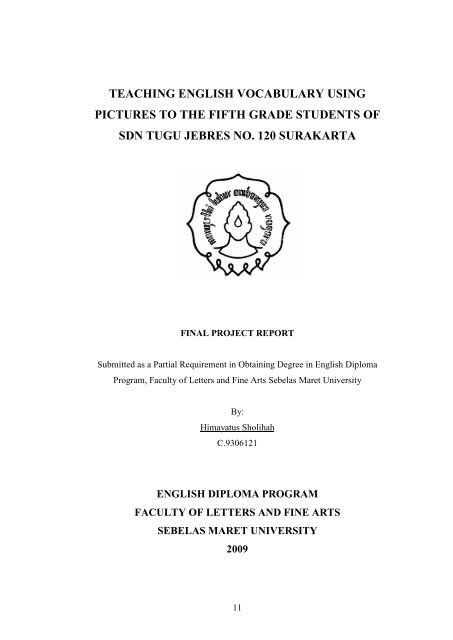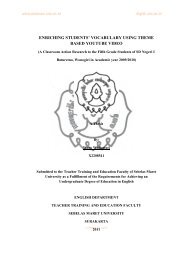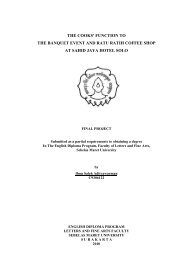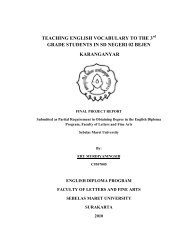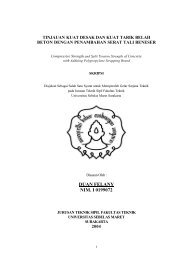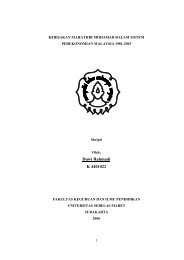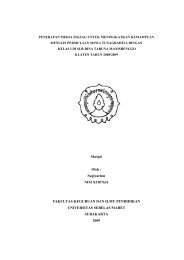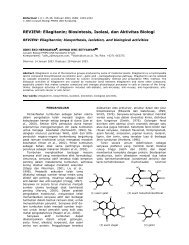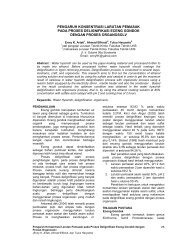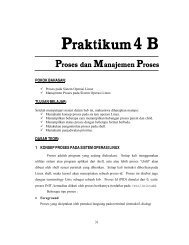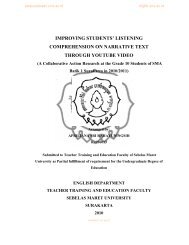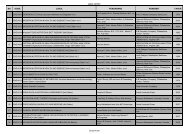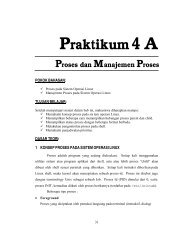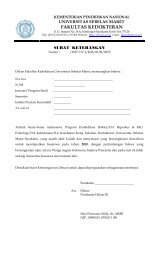teaching english vocabulary using pictures to the fifth grade students ...
teaching english vocabulary using pictures to the fifth grade students ...
teaching english vocabulary using pictures to the fifth grade students ...
- No tags were found...
You also want an ePaper? Increase the reach of your titles
YUMPU automatically turns print PDFs into web optimized ePapers that Google loves.
TEACHING ENGLISH VOCABULARY USINGPICTURES TO THE FIFTH GRADE STUDENTS OFSDN TUGU JEBRES NO. 120 SURAKARTAFINAL PROJECT REPORTSubmitted as a Partial Requirement in Obtaining Degree in English DiplomaProgram, Faculty of Letters and Fine Arts Sebelas Maret UniversityBy:Himayatus SholihahC.9306121ENGLISH DIPLOMA PROGRAMFACULTY OF LETTERS AND FINE ARTSSEBELAS MARET UNIVERSITY200911
12TEACHING ENGLISH VOCABULARY USING PICTURES TO THE FIFTHGRADE STUDENTS OF SDN TUGU JEBRES NO.120 SURAKARTAHimayatus Sholihah 1Drs. S. Budi Waskita, M.Pd 2ABSTRACT2009. English Diploma Program, faculty of Letters and Fine Arts, Sebelas MaretUniversity Surakarta.This final project is written based on <strong>the</strong> job training which has been done by <strong>the</strong> writer inSDN Tugu Jebres No.120 Surakarta. The purpose of this final project is <strong>to</strong> describe <strong>the</strong>process of <strong>using</strong> <strong>pictures</strong> in <strong>teaching</strong> English <strong>vocabulary</strong> and <strong>to</strong> explain <strong>the</strong> influences of<strong>using</strong> <strong>pictures</strong> in <strong>teaching</strong> English <strong>vocabulary</strong> <strong>pictures</strong> <strong>to</strong> <strong>the</strong> <strong>fifth</strong> <strong>grade</strong> <strong>students</strong> of SDNTugu Jebres No.120 Surakarta.The class activities consisted of four steps based on <strong>the</strong> lesson plan that was made before.They are: Warming up that was done <strong>to</strong> make <strong>students</strong> interested in learning and <strong>to</strong>introduce <strong>the</strong> materials. Presentation in which <strong>the</strong> writer presented <strong>the</strong> materials by <strong>using</strong><strong>pictures</strong> as visual media in order <strong>to</strong> explain <strong>the</strong> material clearly and easily <strong>to</strong> understand.There are many activities in this part, such as Listening, Writing, Speaking and Reading.Skill practice is used <strong>to</strong> know <strong>the</strong> <strong>students</strong>’ progress in <strong>the</strong> material that has beenexplained before, and <strong>the</strong> assessment <strong>to</strong> evaluate <strong>the</strong> <strong>students</strong>’ understanding about <strong>the</strong>lesson and <strong>the</strong> writer’s way of <strong>teaching</strong>.The writer found out <strong>the</strong> positive effects of <strong>using</strong> <strong>pictures</strong> in <strong>teaching</strong> English <strong>vocabulary</strong>,<strong>the</strong>se are: <strong>the</strong> <strong>pictures</strong> could improve <strong>the</strong> <strong>students</strong>’ motivation, <strong>the</strong> <strong>pictures</strong> could attract<strong>the</strong> <strong>students</strong>’ attention, <strong>the</strong> <strong>pictures</strong> help <strong>the</strong> <strong>students</strong> <strong>to</strong> memorize <strong>the</strong> <strong>vocabulary</strong> and <strong>the</strong><strong>pictures</strong> make <strong>the</strong> <strong>teaching</strong> and learning activities interesting. To improve <strong>the</strong> quality ofEnglish <strong>teaching</strong> and learning in SDN Tugu Jebres no.120 Surakarta, it is suggested that<strong>the</strong> English teacher had <strong>to</strong> create <strong>the</strong> suitable technique in improving <strong>the</strong> <strong>students</strong>’motivation in learning English <strong>vocabulary</strong>. SDN Tugu Jebres No.12o surakarta shouldalso provide <strong>the</strong> <strong>teaching</strong> media that are useful <strong>to</strong> support <strong>the</strong> English <strong>teaching</strong> process.1 Mahasiswa Jurusan D III Bahasa Inggris dengan NIM C 93061212 Dosen Pembimbing
13CHAPTER IINTRODUCTIONA. BackgroundEnglish is an international language. As we know that English is a way <strong>to</strong>get through <strong>the</strong> international communication in globalization era. It is spoken bymany people all over <strong>the</strong> world. English is also a key <strong>to</strong> open doors <strong>to</strong> scientificand technical knowledge which is needed for <strong>the</strong> economic, politic, social, culture,<strong>to</strong>urism and many o<strong>the</strong>r fields. Ano<strong>the</strong>r fact of <strong>the</strong> importance of English is a <strong>to</strong>prequirement of those seeking jobs, because many occupations require people whohave an English competence. From <strong>the</strong> facts above, it is obvious that everybodyneeds English <strong>to</strong> greet <strong>the</strong> global era.Nowadays, mastering English language is very important for most people,especially <strong>students</strong>. In recent years, a number of elementary schools have begun <strong>to</strong>introduce English in<strong>to</strong> <strong>the</strong>ir curriculum. At elementary schools, English isintroduced <strong>to</strong> <strong>the</strong> <strong>students</strong>’ thourgh learning its <strong>vocabulary</strong> because it is <strong>the</strong> mostimportant element that will become <strong>the</strong> basic competence in order <strong>to</strong> get o<strong>the</strong>rcompetences like listening, speaking, reading and writing. Vocabulary is also as<strong>the</strong> fundamental component <strong>to</strong> enable <strong>the</strong> <strong>students</strong> <strong>to</strong> speak English.In <strong>teaching</strong> English <strong>to</strong> children, <strong>the</strong> teacher should pay attention not onlyon how <strong>the</strong> right implementation <strong>the</strong> techniques used but also on how <strong>the</strong>se
14techniques are suited <strong>to</strong> <strong>the</strong> elementary <strong>students</strong>’ characteristics. It is <strong>the</strong> target <strong>to</strong>create <strong>the</strong> <strong>teaching</strong> learning process more interesting <strong>to</strong> <strong>the</strong> children.Every teacher wants <strong>to</strong> run <strong>the</strong> <strong>teaching</strong> learning process effectively. Theuse of media is aimed <strong>to</strong> enable <strong>the</strong> <strong>students</strong> <strong>to</strong> get <strong>the</strong> lesson and give anenjoyable atmosphere in classroom <strong>to</strong> encourage <strong>the</strong> <strong>students</strong>’ motivation and<strong>students</strong>’ interest <strong>to</strong> <strong>the</strong> lesson.Pictures are very helpful media especially <strong>to</strong> avoid misunderstanding of<strong>the</strong> questions since <strong>the</strong> <strong>students</strong> can relate <strong>the</strong> questions <strong>to</strong> <strong>the</strong> <strong>pictures</strong> given.Pictures have an important role in <strong>the</strong> understanding of meaning. They giveillustration of something and make it clear. Pictures are used <strong>to</strong> help <strong>students</strong> <strong>to</strong>understand and comprehend something clearly and easily.Based on <strong>the</strong> previous explanation <strong>the</strong> writer decides <strong>to</strong> write a finalproject entitled:“Teaching English Vocabulary Using Pictures <strong>to</strong> <strong>the</strong> Fifth Grade Students ofSDN Tugu Jebres No.120, Surakarta.”
15B. The ObjectivesBased on <strong>the</strong> background explanation above, <strong>the</strong> objectives of this finalproject are:1. To describe <strong>the</strong> process of <strong>teaching</strong> English Vocabulary through <strong>pictures</strong>at <strong>the</strong> <strong>fifth</strong> <strong>grade</strong> <strong>students</strong> of SDN Tugu jebres No.120,Surakarta.2. To explain <strong>the</strong> influences of <strong>using</strong> <strong>pictures</strong> in <strong>teaching</strong> English <strong>vocabulary</strong><strong>to</strong> <strong>the</strong> <strong>fifth</strong> <strong>grade</strong> <strong>students</strong> of SDN Tugu Jebres No. 120,Surakarta.C. BenefitsThe writer hopes that <strong>the</strong> final project result can give some benefits forseveral sides <strong>the</strong>y are:1. SDN Tugu JebresIt is expected that <strong>the</strong> final project can give useful input <strong>to</strong> <strong>the</strong>teachers in improving its quality of <strong>teaching</strong> learning process <strong>to</strong>elementary <strong>students</strong>.2. English Diploma StudentsIt is expected that <strong>the</strong> final project can give some advantages <strong>to</strong> <strong>the</strong><strong>students</strong> who need additional information about <strong>teaching</strong> <strong>vocabulary</strong> <strong>to</strong>elementary <strong>students</strong>.
16CHAPTER IILITERATURE REVIEWA. Teaching and Learning Process1. TeachingAccording <strong>to</strong> Wright, “Teaching is essentially social activities,implying role relationship between <strong>the</strong> teacher and learners, learners andlearners. (Wright, 1987:10)According <strong>to</strong> Brown, Teaching may be defined as “showing or helpingsomeone <strong>to</strong> learn how <strong>to</strong> do something, giving instructions, guiding in <strong>the</strong>study of something, providing with knowledge, ca<strong>using</strong> <strong>to</strong> know orunderstand.” (Brown, 2000:7)The improvement of student’s quality depends on <strong>the</strong> quality of <strong>the</strong>teacher. A good relationship between a teacher and learners will support<strong>teaching</strong> learning process. This condition gives positive contributions for <strong>the</strong>improvement or progress in <strong>teaching</strong> activity.2. LearningNana sudjana says that Learning is process signed with <strong>the</strong> presence ofsomeone’s changes. The change in performance as a result of study can beshown in various forms, such as change in knowledge, understanding,behavior and attitude, skill ability and o<strong>the</strong>r aspect of change that is studied by
17<strong>the</strong> learner. (Nana sudjana, 1996:5).According <strong>to</strong> Wenden and Rubin Teachingand Learning can be influenced by two fac<strong>to</strong>rs:1. Internal Fac<strong>to</strong>ra. AgeLanguage learning will be better <strong>to</strong> begin under eleven years old,namely during <strong>the</strong> linguistic period.b. MotivationThe children need motivation <strong>to</strong> get success in English learning.c. IntelligentThe student’s intelligence shows whe<strong>the</strong>r <strong>the</strong> children are able <strong>to</strong> face<strong>the</strong> challenge or not.d. First Language BackgroundThe different concept of <strong>the</strong> first language will make <strong>students</strong> difficult<strong>to</strong> learn <strong>the</strong> second language.e. ExperienceThe success or failure in <strong>the</strong> previous learning affects <strong>the</strong> student’sexpectations and attitudes.2. External Fac<strong>to</strong>ra. Language EnvironmentIn learning English, <strong>the</strong> learner is influenced by <strong>the</strong> languageenvironment.
18b. The TeacherThe success of children’s learning is determined by <strong>the</strong> roles of <strong>the</strong>teachers in <strong>teaching</strong> activities.(Wenden and Rubin, 1998)B. The Teaching Vocabulary1. VocabularyThe basic unit in learning language is word or <strong>vocabulary</strong>. Knowing<strong>vocabulary</strong> has big influence in learning English. There are some definitionsof vocabularies. Penny Ur defines that <strong>vocabulary</strong> as <strong>the</strong> words that are taughtin foreign language. A new item of <strong>vocabulary</strong> may be more than a singleword which are made up of two or three words but express a single idea.(Penny Ur, 1996:60)According <strong>to</strong> Hornby in <strong>the</strong> Oxford advanced learner’s dictionary ofcurrent English, it is stated that <strong>vocabulary</strong> is <strong>the</strong> <strong>to</strong>tal number of words in alanguage, all words known <strong>to</strong> a person or used in a particular book, subject,etc. ( Hornby, 1995:959)From <strong>the</strong> explanation above, it can be summarized that <strong>vocabulary</strong> is<strong>the</strong> <strong>to</strong>tal number of words, including meaning and information.
192. The Importance of Teaching VocabularyVocabulary is one basic component <strong>to</strong> develop English as a foreignlanguage at elementary, intermediate, or advance levels. It plays importantroles <strong>to</strong> support o<strong>the</strong>r language skills such as listening, speaking reading, andwriting. Coady and Huckin state “<strong>vocabulary</strong> is central <strong>to</strong> language and ofcritical importance <strong>to</strong> <strong>the</strong> typical language learner.” (Coady and Huckin,1997:5)McCarthy has a statement about <strong>the</strong> importance of <strong>vocabulary</strong>, hestates “No matter how well <strong>the</strong> <strong>students</strong> learns grammar , no matter howsuccessfully <strong>the</strong> sounds of L2 are mastered , without words <strong>to</strong> express a widerrange of meaning, communication in L2 just cannot happen in any meaningfulway. (McCarthy, 1990: iii)Rivers in Nunan says that <strong>the</strong> acquisition of an adequate <strong>vocabulary</strong> isessential for successful second language use because without an extensive<strong>vocabulary</strong>, we will be unable <strong>to</strong> use <strong>the</strong> structures and functions that we mayhave learned for comprehensible communication.(Rivers in Nunan, 1991: 117)From <strong>the</strong> opinion above, it can be concluded that <strong>vocabulary</strong> is veryimportant <strong>to</strong> achieve language skills as listening, reading, speaking andwriting.
20C. Teaching English Vocabulary <strong>to</strong> Young LearnersThe focus of English <strong>teaching</strong> learning at elementary schools is on <strong>the</strong><strong>vocabulary</strong>. Students in elementary schools can be called young learners. SarahPhilips defines that young learners mean children from <strong>the</strong> first year formalschooling (five or six years old) <strong>to</strong> eleven or twelve year age. ( Philips, 1996:5).Teaching English <strong>to</strong> young learners are different from <strong>teaching</strong> adultlearners. Related <strong>to</strong> <strong>teaching</strong> and learning process, <strong>the</strong> <strong>students</strong> as <strong>the</strong> younglearners require <strong>the</strong> different treatment and situation that is more attractive,various, and interesting. Jeremy Harmer states, more than anything else, childrenare curious and this in itself is motivating. At <strong>the</strong> same time <strong>the</strong>ir span of attentionor concentration is less than that of an adult. (Jeremy Harmer, 1991).According <strong>to</strong> Brumfit, it is a commonplace that young children learnbetter through play or at least can be induced <strong>to</strong> go along with <strong>teaching</strong> that istempered by ‘fun’ activities. The <strong>students</strong> as young learners need more fun andinteresting atmosphere in <strong>the</strong>ir <strong>teaching</strong> and learning process. (Brumfit, 1995:33).As Ytreberg says, most activities for young learners should include movement andinvolve <strong>the</strong> senses. The teacher will need <strong>to</strong> have plenty of objects and <strong>pictures</strong>.(Ytreberg, 1998:5)From <strong>the</strong> explanation above, it can be concluded that young learners havedifferent characteristics from adult learners. Then, <strong>the</strong> <strong>teaching</strong> and learningprocess needs special techniques suitable with <strong>the</strong> characteristics of <strong>the</strong> young
21learners. The Use of <strong>pictures</strong> is one of techniques that are appropriate with <strong>the</strong>characteristics of <strong>the</strong> young learnersD. PicturePictures as a part of visual aids are used as a technique in <strong>teaching</strong> English<strong>vocabulary</strong> at elementary schools. Pictures that can be sketches, drafts, graphs,comic, poster, car<strong>to</strong>on, board drawing, picture in newspapers, magazines, posters,family pho<strong>to</strong>graph, calendars, wall chart, Slides, diagrams and maps are widelyused as media. According <strong>to</strong> Webster, picture is an image or likeness of an object,person, scene, reproduced, on flat surface, especially by painting, of pho<strong>to</strong>graphy;a metal image or impression; an idea. (Webster, 1983:1357)Pictures can be used <strong>to</strong> explain <strong>the</strong> meaning of <strong>vocabulary</strong> items. VirginiaFrench says that for helping <strong>students</strong> <strong>to</strong> understand <strong>the</strong> meaning of a word, apicture is useful. (Virginia French, 1983)E. The Use of Pictures in Teaching English VocabularyIn <strong>teaching</strong> and learning process, <strong>the</strong> role of <strong>using</strong> <strong>pictures</strong> as media hasbecome <strong>the</strong> best choice in <strong>teaching</strong> English especially in <strong>vocabulary</strong> <strong>to</strong> <strong>the</strong>elementary <strong>students</strong>. Pictures are important <strong>to</strong> help <strong>the</strong> <strong>students</strong> in learningEnglish <strong>vocabulary</strong> and memorizing <strong>the</strong> meanings. Ur says that visual have an
22important function as aids <strong>to</strong> learning simply because <strong>the</strong>y attract student’sattention and help encourage <strong>the</strong>m <strong>to</strong> focus on <strong>the</strong> subject in hand. (Ur, 1948: 30)Wright states that <strong>pictures</strong> can play a key role in motivating <strong>students</strong>contextualizing <strong>the</strong> language <strong>the</strong>y are <strong>using</strong>, giving <strong>the</strong>m a reference and helping<strong>to</strong> discipline <strong>the</strong> activity. (Wright, 1989:2).Wright states some roles for <strong>pictures</strong> inspeaking and writinga. Pictures can motivate <strong>students</strong> and make him or her want <strong>to</strong> pay attentionand take apart.b. Pictures contribute <strong>to</strong> <strong>the</strong> context in which language is being used.c. Pictures can be described in an objective way or interpreted or respondedsubjectively.d. Pictures can cue responses <strong>to</strong> questions or cue substitutions throughcontrolled practice.e. Pictures can stimulate and provide information <strong>to</strong> be referred <strong>to</strong> inconversation, discussion, and s<strong>to</strong>rytelling.(Wright, 1989:17)From <strong>the</strong> explanation above it can be seen that Pictures are useful <strong>to</strong> focus<strong>the</strong> <strong>students</strong>’ attention <strong>to</strong> imagine on what <strong>the</strong> text says. Pictures are notambiguous; a picture should contain only what <strong>the</strong> word means. Using picture isalso an effort <strong>to</strong> help <strong>students</strong> <strong>to</strong> understand and comprehend something clearlyand easily. However, <strong>teaching</strong> <strong>using</strong> <strong>pictures</strong> have an important role in <strong>the</strong>understanding. It means that <strong>using</strong> picture can be a good technique in <strong>teaching</strong>English <strong>vocabulary</strong> <strong>to</strong> <strong>the</strong> children.
23CHAPTER IIIDISCUSSIONA. The Description of SDN Tugu Jebres NO. 120 SurakartaSDN Tugu Jebres NO. 120 Surakarta is located at kentingan Rt 01 Rw XI,Jebres, Surakarta, side by side with SDN tegalkuniran No. 183. The school isestablished in <strong>the</strong> land area of 1,5 hectares. This institution was built on May 20,1970. The school so far has tried its level best <strong>to</strong> improve school activities.The buildings consists of 11 classrooms and 6 for o<strong>the</strong>r rooms. Theschool’s facilities support <strong>the</strong> <strong>students</strong> including; Library, Mosque, canteen,bathrooms, parking area, health centre, schoolyard, etc.In academic year, 2008/2009 <strong>the</strong> number of <strong>the</strong> <strong>students</strong> is 270 dividedin<strong>to</strong> 6 classes, with <strong>the</strong> detail below:Class 1Class 2Class 3Class 4Class 5Class 6: 46 <strong>students</strong>: 48 <strong>students</strong>: 46 <strong>students</strong>: 42 <strong>students</strong>: 50 <strong>students</strong>: 41 <strong>students</strong>Meanwhile <strong>the</strong> number of teachers is 13 persons, consisting of six classteachers, three religion teachers, one English teacher, one sport teacher, onemulok teacher, and one art teacher. The teachers are responsible for <strong>the</strong> <strong>teaching</strong>and learning process.
24The vision of SDN Tugu Jebres No.120 Surakarta is “Excellent on qualityand noble character. These are five Missions of SDN Tugu Jebres No.120Surakarta:1. Implementing <strong>the</strong> conviction, <strong>the</strong> belief <strong>to</strong> one God2. Creating <strong>the</strong> <strong>students</strong> <strong>to</strong> be good characters and noble characters3. Creating <strong>the</strong> <strong>students</strong> <strong>to</strong> have broad knowledge and technology4. Creating <strong>the</strong> <strong>students</strong> <strong>to</strong> have <strong>the</strong> academic and non-academic achievement5. Creating <strong>the</strong> <strong>students</strong> who ready <strong>to</strong> use in <strong>the</strong> academic and non-academicactivitiesSome extracurricular activities of SDN Tugu Jebres Surakarta are:1. ScoutingThe Scout activity at SDN Tugu Jebres plays a great role <strong>to</strong> actualize perfectpersonality and mentality of <strong>the</strong> <strong>students</strong>. The scout activity is held on Friday,at 15.00 pm up <strong>to</strong> 17.00 pm. This activity is taught for <strong>the</strong> <strong>students</strong> of classthree up <strong>to</strong> class six. Through Scout activities, <strong>the</strong> <strong>students</strong> train <strong>the</strong>ir skillsand actualize <strong>the</strong>ir creativities <strong>to</strong> prepare <strong>the</strong> real life in <strong>the</strong>ir own community.2. Traditional DanceThis Traditional dance activity held based on <strong>the</strong> schedule of each class. Theaim of this activity is <strong>to</strong> preserve Indonesia culture. This activity is taught for<strong>the</strong> <strong>students</strong> of class four up <strong>to</strong> class six.3. KarawitanKarawitan is held before <strong>the</strong> regular academic activity at 6 am up <strong>to</strong> 7 am.This activity is taught for <strong>the</strong> <strong>students</strong> of class three up <strong>to</strong> class five.
The Organization Structure of SDN Tugu Jebres NO.120 SurakartaORGANIZATION STRUCTUREHEAD MASTERDrs. BUDI PARYONO, S.H.,M.H.SCHOOL COMMITTEE1 ST GRADETEACHERLIBRARY UNITMARIA DAREA, 2 ND GRADE S. Th.TEACHER3 RD GRADETEACHER4 TH GRADETEACHERDrs. HENDRAT P.S.H.,M.SiADMINISTRATION5 TH GRADETEACHER6 S GRADETEACHERSRI MARYATI SUPRAPTI, S. Pd. KRISTANTI SR DEWI IRIANINGSIH SRI SUPADMI SUNARLANISLAMIC CRISTIAN TEACHER SPORT TEACHER ENGLISH TEACHER MULOK TEACHERART TEACHERMARIA BISRI DAREA, M, S. Ag. S.ThSUWARSONOSITI RACHMAWATISUTARDI, S.Sn. SCHOOL GUARD MARIA DAREA, S.ThCHATOLIC TEACHERSTUDENTSPARJORETNO W, S.PdSOCIETY13
The explanation of <strong>the</strong> main dutyo Headmaster• To undertake and control <strong>the</strong> whole activities of <strong>the</strong> schoolo The School Committee• Responsible <strong>to</strong> give advice in determining <strong>the</strong> school policyo Administration• Giving responsible <strong>to</strong> <strong>the</strong> head master about <strong>the</strong> school administration• Managing <strong>the</strong> school administrationo Library Unit• Opening library based on schedule• Managing <strong>the</strong> book classification• Making a report about <strong>the</strong> thing and <strong>the</strong> activities in <strong>the</strong> libraryo A Teacher Class• Responsible for <strong>the</strong> <strong>teaching</strong> <strong>the</strong> general subjects.o The Religion Teacher• Responsible in <strong>teaching</strong> religion’s subject. SDN Tugu Jebres has threereligion teachers; <strong>the</strong>y are an Islamic religion teacher, a Christian religionteacher and a catholic religion teacher.o A Sport Teacher• Responsible in <strong>teaching</strong> sport <strong>to</strong> <strong>the</strong> <strong>students</strong>• Control on <strong>the</strong> sport activities26
27o An English Teacher• Responsible in <strong>teaching</strong> English’s subject. SDN Tugu Jebres has anEnglish teacher, he teaches <strong>the</strong> whole classo Mulok Teacher• Responsible in <strong>teaching</strong> Mulok’s subject.o An Art Teacher• Responsible in <strong>teaching</strong> art <strong>to</strong> <strong>the</strong> <strong>students</strong>, such as making craft, singing<strong>the</strong> traditional song, and drawing lessonso School Guard• Keeping <strong>the</strong> cleanliness of <strong>the</strong> school environmentB. Job Training Activities· Class ObservationThe job training was done from January 30, 2009 up <strong>to</strong> February 28, 2009.The <strong>teaching</strong> and learning process takes place in <strong>the</strong> <strong>fifth</strong> Grade <strong>students</strong> of SDNTugu Jebres. The classroom is situated between <strong>the</strong> kindergarten and <strong>the</strong> 6 th <strong>grade</strong>class. There are 50 <strong>students</strong>: 19 boys and 31 girls. This classroom has 25 tables,50 chairs, one blackboard, one cupboard, chalk box, eraser, calendar, pho<strong>to</strong> of <strong>the</strong>president, pho<strong>to</strong> of <strong>the</strong> vice president, clock, lamp, trashcan, bookshelves, desk,rules, and <strong>pictures</strong>. The classroom looks very clean.
28Before <strong>the</strong> <strong>teaching</strong> and learning activities, <strong>the</strong> class leader alwaysleads <strong>the</strong>m <strong>to</strong> pray first. English lesson is conducted twice in a week, each studentis demanded <strong>to</strong> have LKS which are provided by <strong>the</strong> school. The teacher has avery nice relationship with all <strong>the</strong> <strong>students</strong>.C. Material PreparationTo support <strong>the</strong> success of English <strong>teaching</strong> learning activity needs welltimemanagement. The writer arranged <strong>the</strong> materials that would be given in alesson plan. The lesson plan is made <strong>to</strong> plan <strong>the</strong> learning activity based on <strong>the</strong>chapter in <strong>the</strong> LKS. It means that a lesson plan will help <strong>the</strong> teacher a lot inconducting <strong>teaching</strong> learning process. The writer prepared colored <strong>pictures</strong> as <strong>the</strong>media <strong>to</strong> teach <strong>the</strong> material clearly and easily <strong>to</strong> understand. In arranging <strong>the</strong>lesson plan, <strong>the</strong> writer discussed it first with <strong>the</strong> English teacher. Then, <strong>the</strong> lessonplan has <strong>to</strong> be assigned by <strong>the</strong> head master.All of <strong>the</strong> preparation above was arranged in<strong>to</strong> <strong>the</strong> lesson plan enclosed in<strong>the</strong> appendices.D. The Teaching and Learning ActivitiesAfter making <strong>the</strong> lesson plan, <strong>the</strong> writer applied it in <strong>the</strong> class. The allottedtime for <strong>teaching</strong> English was 35 minutes for one lesson.
29Before beginning <strong>the</strong> class, both <strong>the</strong> writer and <strong>the</strong> <strong>students</strong> prayed<strong>to</strong>ge<strong>the</strong>r. This activity is always done before beginning <strong>the</strong> lesson. After that, <strong>the</strong>writer greeted <strong>the</strong> <strong>students</strong>Writer : Assalamu’alaikum Wr. WbStudents : Wa’alaikumsalam Wr. WbWriter : Good morning StudentsStudents : Good morning MissWriter : How are you <strong>to</strong>day?Students : I am fine thank you and youWriter : I am fine <strong>to</strong>oThis activity was done in <strong>the</strong> beginning of <strong>the</strong> class meeting <strong>to</strong> make <strong>the</strong><strong>students</strong> familiar <strong>to</strong> say greeting in English. Then, <strong>the</strong> writer started <strong>to</strong> explain <strong>the</strong>lesson.To start <strong>the</strong> lesson <strong>the</strong> writer asked some questions related <strong>to</strong> <strong>the</strong> material.She used <strong>pictures</strong> in order <strong>to</strong> attract <strong>the</strong>ir attention in learning Englishvocabularies. By <strong>using</strong> <strong>pictures</strong>, Students will be stimulated <strong>to</strong> say somethingbased on what <strong>the</strong>y see.The writer prepared colored picture series related <strong>to</strong> <strong>the</strong> <strong>to</strong>pic <strong>to</strong> help herpresent <strong>the</strong> material and <strong>to</strong> make <strong>the</strong> <strong>students</strong> more interested <strong>to</strong> learn.After explaining <strong>the</strong> material, <strong>the</strong> writer gave some exercises in order <strong>to</strong>check whe<strong>the</strong>r <strong>the</strong> <strong>students</strong> have already unders<strong>to</strong>od <strong>the</strong> material given.
30E. Using Pictures in Teaching English VocabulariesThe process of <strong>teaching</strong> English vocabularies by <strong>using</strong> <strong>pictures</strong> <strong>to</strong> <strong>the</strong> <strong>fifth</strong><strong>grade</strong> <strong>students</strong> consists of four steps as follows:1. Warming upWarming up is <strong>the</strong> first step in <strong>the</strong> <strong>teaching</strong> process. In this stage, <strong>the</strong>writer presented <strong>the</strong> new materials <strong>to</strong> <strong>the</strong> <strong>students</strong>. The writer did it by asking<strong>the</strong> <strong>students</strong> some questions related <strong>to</strong> <strong>the</strong> material or <strong>the</strong> <strong>to</strong>pic beingdiscussed, for example, if <strong>the</strong> <strong>to</strong>pic was about transportation, <strong>the</strong> writer wouldask <strong>the</strong> <strong>students</strong> some questions as follows:Do you know what transportations are?Can you mention ano<strong>the</strong>r kind of transportation?This activity was done <strong>to</strong> introduce <strong>the</strong> new <strong>to</strong>pic <strong>to</strong> <strong>the</strong> <strong>students</strong>.2. PresentationIn <strong>the</strong> second activity, <strong>the</strong> writer began <strong>to</strong> explain <strong>the</strong> materials <strong>to</strong> <strong>the</strong><strong>students</strong>. In learning English, <strong>the</strong>re are four skills, which must be mastered.They were listening, speaking, writing, and reading. Then, <strong>the</strong> writer taught it<strong>to</strong> <strong>the</strong> <strong>fifth</strong> <strong>grade</strong> <strong>students</strong>. In this step, <strong>the</strong> teacher can use some media of<strong>teaching</strong> <strong>to</strong> help <strong>the</strong> teacher explains <strong>the</strong> material easily.a. Teaching ListeningIn <strong>teaching</strong> <strong>the</strong> listening skill by <strong>using</strong> <strong>pictures</strong>, <strong>the</strong> writer gave <strong>the</strong>materials by asking <strong>the</strong> <strong>students</strong> <strong>to</strong> listen <strong>to</strong> her and <strong>the</strong>n repeat after her.For example, when <strong>the</strong> <strong>to</strong>pic was transportation, <strong>the</strong> writer showed some
31<strong>pictures</strong> of transportation and mentioned <strong>the</strong>ir names, and <strong>the</strong>n she asked<strong>the</strong> <strong>students</strong> <strong>to</strong> repeat saying <strong>the</strong> names of objects after her. For examples:WriterStudents: Car: CarWriterStudents: Mo<strong>to</strong>rcycle: Mo<strong>to</strong>rcycleWriterStudents: Helicopter: HelicopterIn this skill, <strong>the</strong> writer used <strong>pictures</strong> <strong>to</strong> make <strong>the</strong> <strong>students</strong> interestedin learning. After <strong>the</strong>y finished and <strong>the</strong> <strong>students</strong> knew <strong>the</strong> names of all <strong>the</strong>objects on <strong>the</strong> <strong>pictures</strong>, <strong>the</strong> writer showed <strong>the</strong> <strong>pictures</strong> again one by oneand asked <strong>the</strong> <strong>students</strong> <strong>to</strong> say <strong>the</strong> names of <strong>the</strong> thing <strong>to</strong> check whe<strong>the</strong>r <strong>the</strong>ylistened <strong>to</strong> her well or not.b. Teaching SpeakingIn <strong>teaching</strong> speaking, <strong>the</strong> writer led <strong>the</strong> <strong>students</strong> <strong>to</strong> somecommunicative activities. She used <strong>pictures</strong> <strong>to</strong> make her easier indelivering <strong>the</strong> materials. When <strong>the</strong> <strong>to</strong>pic is about transportation, she
32showed some picture of <strong>the</strong> transportation. Then, she asked some <strong>students</strong><strong>to</strong> answer <strong>the</strong> questions about <strong>the</strong> <strong>pictures</strong>, for example:WriterStudentsWriterStudents: What is this?: Pedicab: How do you spell it?: /pie/ /ie/ /die/ /ai/ /sie/ /ei/ bie/WriterDesiWriterDesiWriter: Desi. What is this?: Ship: How do you spell it?: /es/ /eic/ /ai/ /pie/: Very goodThis activity could make <strong>the</strong> <strong>students</strong> understand <strong>the</strong> objects andhelp <strong>the</strong>m say <strong>the</strong> names of <strong>the</strong> objects properly.c. Teaching ReadingReading is important when <strong>the</strong> learners are learning a newlanguage. In <strong>teaching</strong> <strong>the</strong> reading skills by <strong>using</strong> <strong>pictures</strong>, <strong>the</strong> writer read<strong>the</strong> <strong>vocabulary</strong> twice <strong>to</strong> make it more clearly, <strong>the</strong>n asked <strong>the</strong> <strong>students</strong> <strong>to</strong>read it aloud <strong>to</strong>ge<strong>the</strong>r after <strong>the</strong> writer did. After that, she randomly pointeda student <strong>to</strong> read <strong>the</strong> <strong>vocabulary</strong> aloud. For example:
33Train (trein)Plane (plein)d. Teaching WritingIn <strong>teaching</strong> <strong>the</strong> writing skill by <strong>using</strong> <strong>pictures</strong>, <strong>the</strong> writer mustexplain how <strong>to</strong> write <strong>the</strong> correct letter. Then, <strong>the</strong> writer asked <strong>students</strong> <strong>to</strong>write <strong>the</strong> <strong>vocabulary</strong> on <strong>the</strong> blackboard. They write <strong>the</strong> vocabularies basedon <strong>the</strong> <strong>pictures</strong>. For example:What is this?This is a busWhat is this?This is pedicab3. Skill PracticeSkill practice is <strong>the</strong> third step in <strong>teaching</strong> and learning activity. Thisactivity is used <strong>to</strong> know <strong>the</strong> <strong>students</strong>’ progress in <strong>the</strong> material that has beenexplained before.
34o The teacher prepares some <strong>pictures</strong> about transportation, for example:o The teacher shows <strong>the</strong> <strong>pictures</strong> one by oneo Students should write <strong>the</strong> answer on <strong>the</strong> board. Then <strong>the</strong>y must pronounceit well.o If <strong>the</strong>y could answer it well, <strong>the</strong> writer gave a gift.4. AssessmentThis is <strong>the</strong> last step in <strong>teaching</strong> and learning activity. It is carriedout <strong>to</strong> know how far <strong>the</strong> <strong>students</strong> understand <strong>the</strong> material. It is also used <strong>to</strong>know <strong>the</strong> writer’s way of <strong>teaching</strong> as an input <strong>to</strong> make a better way oflearning.In <strong>the</strong> assessment step, <strong>the</strong> writer asked <strong>the</strong> <strong>students</strong> <strong>to</strong> do <strong>the</strong>exercise in <strong>the</strong>ir worksheet related <strong>to</strong> <strong>the</strong> material that have beenexplained. If <strong>the</strong> time was not enough, <strong>the</strong> writer asked <strong>the</strong> <strong>students</strong> <strong>to</strong> do itas homework. It would be checked in <strong>the</strong> next meeting.
35F. The Influences of Using Pictures in Teaching English VocabularyBased on <strong>the</strong> activities of <strong>teaching</strong> English <strong>vocabulary</strong> through<strong>pictures</strong> at <strong>the</strong> <strong>fifth</strong> <strong>grade</strong> <strong>students</strong> of SDN Tugu Jebres, <strong>the</strong> writer willexplain <strong>the</strong> influences of <strong>using</strong> <strong>pictures</strong> in <strong>the</strong> <strong>teaching</strong> learning process. Theyare as follows:1. To improve <strong>the</strong> <strong>students</strong>’ motivationThe improvement of <strong>the</strong> <strong>students</strong>’ <strong>vocabulary</strong> is quite significant. The<strong>students</strong>’ motivation <strong>to</strong> learn English is getting better when <strong>the</strong>y are shown <strong>the</strong><strong>pictures</strong>. The <strong>students</strong> are very enthusiastic <strong>to</strong> join <strong>the</strong> lesson, includinganswering <strong>the</strong> question and responding <strong>the</strong> teacher’ explanation. Then, highmotivation makes <strong>the</strong> improvement of <strong>students</strong>’ <strong>vocabulary</strong>.2. To attract <strong>the</strong> Students’ attentionPictures are useful <strong>to</strong> focus <strong>the</strong> attention of <strong>the</strong> <strong>students</strong> on what <strong>the</strong>text says by helping him <strong>to</strong> imagine it. When <strong>using</strong> <strong>pictures</strong>, <strong>the</strong> <strong>students</strong>depend on <strong>the</strong> <strong>pictures</strong> and neglect <strong>to</strong> understand <strong>the</strong> context. When <strong>the</strong><strong>students</strong> are attracted <strong>to</strong> <strong>the</strong> <strong>pictures</strong>, <strong>the</strong>y will pay attention more <strong>to</strong> learningEnglish. Pictures have an important function as aids <strong>to</strong> learning simplybecause <strong>the</strong>y attract <strong>students</strong>’ attention and help encourage <strong>the</strong>m <strong>to</strong> focus on<strong>the</strong> subject in hand.3. Pictures help <strong>the</strong> <strong>students</strong> <strong>to</strong> memorize <strong>the</strong> vocabulariesIt is important <strong>to</strong> make sure that <strong>the</strong> <strong>pictures</strong> are not ambiguous; <strong>the</strong>yshould contain only what <strong>the</strong> word means. Using picture is an effort <strong>to</strong> help
36<strong>students</strong> <strong>to</strong> understand and comprehend something clearly and easily.However, <strong>teaching</strong> <strong>using</strong> <strong>pictures</strong> have an important role in <strong>the</strong> understandingof meaning. It means that <strong>using</strong> picture has an impact on <strong>the</strong> memorization of<strong>the</strong> <strong>vocabulary</strong> learning.4. To make <strong>the</strong> <strong>teaching</strong> learning activity more interestingTeaching English vocabularies by <strong>using</strong> picture is <strong>the</strong> process ofmaking <strong>the</strong> <strong>students</strong> more active and interested in English class.The use of <strong>pictures</strong> could give an enjoyable situation in <strong>teaching</strong> andlearning activity, as <strong>the</strong> <strong>students</strong> do not get bored in having English class. Itcould make <strong>the</strong> <strong>teaching</strong> learning activities run well.The explanation above shows that <strong>using</strong> <strong>pictures</strong> in <strong>the</strong> <strong>teaching</strong>English vocabularies is a good technique <strong>to</strong> improve <strong>the</strong> <strong>students</strong>’vocabularies. As <strong>the</strong> result, <strong>the</strong> score of English is increasing well. It canmake a conclusion that <strong>using</strong> <strong>pictures</strong> is necessary and effective in <strong>the</strong><strong>teaching</strong> English <strong>vocabulary</strong>.
37CHAPTER IVCONCLUSION AND SUGGESTIONA. ConclusionsBased on <strong>the</strong> activities of <strong>the</strong> <strong>teaching</strong> English <strong>vocabulary</strong> through<strong>pictures</strong> at <strong>the</strong> <strong>fifth</strong> <strong>grade</strong> <strong>students</strong> of SDN Tugu Jebres No.120, <strong>the</strong>re aresome conclusions that could be drawn from this final project. Those are:1. The process of <strong>using</strong> <strong>pictures</strong> in <strong>teaching</strong> English vocabularies consists of foursteps. They are:A. Warming UpIn this step, <strong>the</strong> writer greeted <strong>the</strong> <strong>students</strong> first. Then, she introducednew materials <strong>to</strong> <strong>the</strong> <strong>students</strong> by asking some questions related <strong>to</strong> <strong>the</strong> materialthat will be explained. Besides that, <strong>the</strong> writer gave a short explanation about<strong>the</strong> material. The writer also used <strong>pictures</strong> <strong>to</strong> attract <strong>students</strong>’ attention.B. PresentationThe second step is presentation. In this step, <strong>the</strong> writer presented <strong>the</strong>materials by <strong>using</strong> <strong>pictures</strong> in order <strong>to</strong> explain <strong>the</strong> material clearly and easily<strong>to</strong> understand. This activity has done by <strong>the</strong> writer because <strong>the</strong> childrenusually get bored in listening <strong>to</strong> <strong>the</strong> teacher’s explanation. Pictures could help<strong>the</strong> <strong>students</strong> <strong>to</strong> focus <strong>the</strong> attention on <strong>the</strong> material taught.25
38C. Skill PracticeSkill practice is <strong>the</strong> third step, it was used <strong>to</strong> know <strong>the</strong> <strong>students</strong>’progress in <strong>the</strong> material that had been explained before. In this step, <strong>the</strong> writertried <strong>to</strong> involve <strong>the</strong> <strong>students</strong> by <strong>using</strong> <strong>pictures</strong> as media.D. AssessmentTo evaluate <strong>the</strong> <strong>students</strong>’ understanding about <strong>the</strong> lesson, <strong>the</strong> writerdid some evaluation by giving some exercises and homework <strong>to</strong> <strong>the</strong> <strong>students</strong>.The exercise given is based on <strong>the</strong> materials in <strong>the</strong> LKS. These assessmentsare also used <strong>to</strong> evaluate <strong>the</strong> writer’s way of <strong>teaching</strong>, whe<strong>the</strong>r it is effectiveor not.2. The influences of <strong>using</strong> <strong>pictures</strong> in <strong>teaching</strong> English vocabularies <strong>to</strong> <strong>the</strong> <strong>fifth</strong><strong>grade</strong> <strong>students</strong> are as follows:a. Pictures could improve <strong>the</strong> <strong>students</strong>’ motivationb. Pictures could attract <strong>the</strong> <strong>students</strong>’ attentionc. Pictures help <strong>the</strong> <strong>students</strong> <strong>to</strong> memorize <strong>the</strong> vocabulariesd. Pictures make <strong>the</strong> <strong>teaching</strong> and learning activities interestingTherefore, <strong>using</strong> <strong>pictures</strong> is necessary and effective in <strong>the</strong> <strong>teaching</strong>English <strong>vocabulary</strong> especially <strong>to</strong> <strong>the</strong> <strong>fifth</strong> <strong>grade</strong> <strong>students</strong> of SDN Tugu JebresNo.120 Surakarta.B. SuggestionsBased on <strong>the</strong> conclusions that have been explained previously, <strong>the</strong>writer would like <strong>to</strong> give some suggestions directed <strong>to</strong> <strong>the</strong> English teacher,SDN Tugu Jebres No. 120, Surakarta, and O<strong>the</strong>r researcher.
391. English teacherThe English teacher should create <strong>the</strong> suitable technique in improving<strong>the</strong> <strong>students</strong>’ motivation in learning English <strong>vocabulary</strong>.2. SDN Tugu Jebres No. 120, SurakartaIt would be better if SDN Tugu Jebres No. 120, Surakarta provides <strong>the</strong><strong>teaching</strong> media that are useful <strong>to</strong> support <strong>the</strong> English <strong>teaching</strong> process so that<strong>the</strong> <strong>teaching</strong> learning process will run effectively.3. O<strong>the</strong>r researcherThis study is just one effort in improving <strong>the</strong> <strong>students</strong>’ <strong>vocabulary</strong>, <strong>the</strong>writer hopes that this final project will be useful <strong>to</strong> conduct <strong>the</strong> o<strong>the</strong>r researchon <strong>the</strong> similar problems.
40BIBLIOGRAPHYAllen, French. Virginia. 1983. Technique in Teaching Vocabulary. New York:Oxford University.Brown, H. Doouglas. 2000. Principles of Language Learning and TeachingFourth edition. New York: Pearson Education.Brumfit, C J Moon and Tongue, R. 1995. Teaching English <strong>to</strong> Children. NewYork: Longman Group Ltd.Coady, James and Huckin, Thomas. 1997. Second Language VocabularyAcquisition. United States: Cambridge University Press.Harmer, Jeremy. 1991. The Practice of English language Teaching. Essex:Longman.Hornby, A.S. 1995. Oxford Advanced Learner’s Dictionary. Oxford: OxfordUniversity Press.McCarthy, Michael. 1990. Vocabulary. Oxford: Oxford University Press.Nunan, David. 1991. Language Teaching Methodology. London: Prentice HallInternational.Philps, S. 1996. Young Learners. Oxford : Oxford University Press.Sudjana, Dr . H. Nana. 1996. Cara Belajar Siswa Aktif Dalam Proses BelajarMengajar. Bandung : Sinar Baru Algesindo.Ur, Penny. 1948. Teaching Listening Comprehension. Cambridge: CambridgeUniversity Press.-------------,1996. A course in Language Teaching. Cambridge: CambridgeUniversity press.Wenden, A and Rubin. J. 1998. Leaner Strategies in English Learning. NewYork: Prentice Hall International.Wright, Andrew. 1997. Picture for language Learning. Cambridge: CambridgeUniversity Press.Wright, Tony. 1987. Roles of Teacher and Learners. Oxford: Oxford UniversityPress.Ytreberg, Lisbet H. Wendy A. Scott. 1998. Teaching English <strong>to</strong> Children.Addison Wesley Longman Limited.


